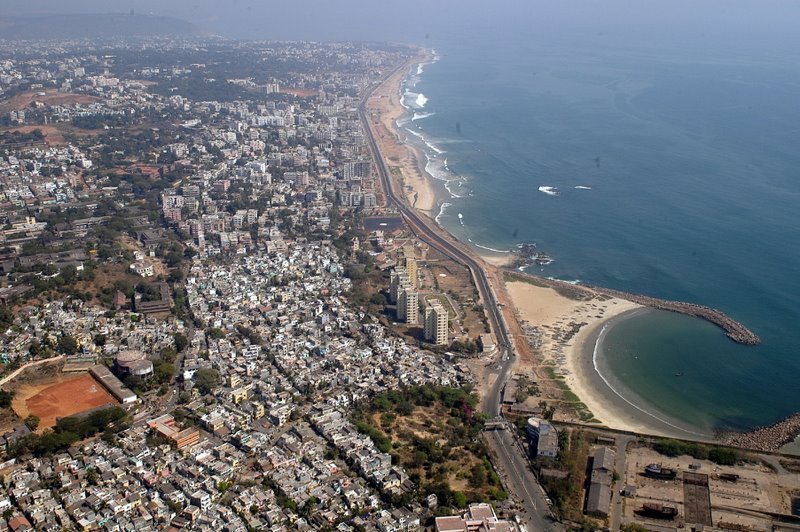
Visakhapatnam: All you need to know about Andhra Pradesh’s new capital

Andhra Pradesh’s capital is set to be relocated from Amaravati to Visakhapatnam, the largest city of the state, Chief Minister YS Jagan Mohan Reddy announced on Tuesday, addressing the preparatory meeting for the Global Investors Summit to be held in Visakhapatnam in March this year.
Nestled amid verdant hills and picturesque valleys, the bustling port city is an industrial centre, dotted with heritage buildings, ancient temples, Buddhists monuments and natural wonders. It is also steeped in golden beaches, art, history, culture. A perfect tourist destination, it is often described as the ‘jewel on the East Coast.’
Vizag: A brief history
Visakhapatnam, also known as Vizag, lies on a small embayment of the Bay of Bengal, about 380 miles northeast of Chennai in Tamil Nadu. A major commercial and administrative centre with road, rail, and air connections, its port is the only protected harbour on the Coromandel Coast; due to its geographical advantage, the city is the headquarters of the Eastern Naval Command of the Indian Navy.
Also read: G-20 meet: As Vizag gets facelift, 60 tribal families in slum face eviction
Visakhapatnam’s name can be found in Hindu and Buddhist texts that date back to ancient times. It has a rich history that dates back to the 6th century BCE, when it was considered part of the Kalinga Kingdom, which was later conquered by the great Emperor, Ashoka (in 260 BC). It was subsequently ruled by the Chankyas, the Rajahmundry Reddy kings, the Cholas and the Golconda Nawabs. During the 15th and 16th centuries, Vizag was under the rule of the Mughals; it was an important centre of trading for the Mughal rulers. Dutch, French and other European merchants used the port for trading in ivory, tobacco, muslin and other products. Towards the end of the 18th century, Visakhapatnam came under the control of the French.
The city of Visakhapatnam has been named after Visakha, the god of valor and war. Visakha is the son of Lord Shiva and Goddess Parvati and is also the ruler of Mars. According to local legend, the city was named Visakhapatnam by an Andhra king between the 9th and 11th century. It is said that the king stopped for a rest in this place on his way to Varanasi, or Benaras. He was so captivated by the beauty of this place that he decided to build a temple in honor of his family deity Visakha. However, according to archaeological records, Vizag was built between the 11th and 12th century by Kulottunga of the Cholas.
Visakhapatnam witnessed manifold development under the British. Some of the establishments of this period include the Andhra Medical College (1902), railway connection to Madras and Calcutta (1904), the Andhra University (1926), Port (1933), Eastern Naval Command (1947), and clubs like the Golf Club and Waltair Club.

Since India gained independence in 1947, Visakhapatnam has emerged as one of the leading ports of the country. In 1949, Scindia Shipyard (HSL) was commissioned; HPCL (Caltex) came up (1957) and in 1981, Visakhapatnam Steel Plant opened its gates. Today, there is a blossoming film industry, chemical industries and the IT parks adding lustre to Vizag’s progress.
Also read: PM lays foundation stone for redevelopment of Vizag Railway station
The city has been an important shipbuilding centre; the first steamer to be built in India was launched in Visakhapatnam’s harbour in 1948. The city boasts of an oil refinery, a steel plant, and industrial complexes for the production of petrochemicals, fertilizer, sugar, and jute; Manganese, oilseeds, and iron ore are exported here. Besides, the city also has a medical college and a medical museum; a submarine museum at Ramakrishna Beach has been drawing tourists from around the world. The presence of software giants and a massive steel and power plant has made Vizag one of the modern faces of India.
The port-based economy
With a GDP of $43.5 billion, Visakhapatnam is the 9th richest city in India. It has the fledgling fishing industry, robust road–rail connectivity, and many heavy industries like Hindustan Petroleum, Visakhapatnam Steel Plant, Hindustan Shipyard, Visakhapatnam Port Trust, National Thermal Power, Bharat Heavy Electricals, BARC, Naval Science and Technological Laboratory, Naval Dockyard, Dredging Corporation of India, Strategic Petroleum Reserve, NMDC, CONCOR, Andhra Pradesh Medtech Zone, among others.
Private sectors like Coromandel International, Ferro Alloys Corporation, Gangavaram Port, etc. have transformed the city from a small hamlet into an industrial hub. With the city blessed with a natural harbour, tourism has played a pivotal role in generating revenue. Sea trade with other countries has also helped boost the economy. The service sector contributes for 55 per cent of the total GDP of Visakhapatnam, while 35 per cent comes from the industrial sector and 10 per cent from agricultural and allied sectors.
The fishing harbour at Visakhapatnam Port is one of the biggest in the coastal corridor of Andhra Pradesh, which exports seafood such as Tuna. Fish preservation by drying, processing and curing activities takes place at the harbour. The dried fish is sent to markets in Tamil Nadu, Karnataka, and Orissa, and also exported to Sri Lanka, Singapore, Burma and others. Ice factories in and outside the Fishing Harbour Visakhapatnam can produce tonnes of ice, catering to the needs of the fishermen, providing industrial employment. The Visakhapatnam Special Economic Zone is a more than 500-acre (200-hectare) free-trade zone at Duvvada, about 15 miles (24 km) southwest of Visakhapatnam, and is connected to the city by train.
The Demography
Out of Visakhapatnam’s total population, 9.88 lakhs are males and 9.71 lakhs are females. The sex ratio is 983 females per 1,000 males. The district has a population of 1869 per sq.km. The current metro area population of Visakhapatnam in 2023 is 2,331,000, a 2.33% increase from 2022. The metro area population of Visakhapatnam in 2022 was 2,278,000, a 2.34% increase from 2021. The metro area population of Visakhapatnam in 2021 was 2,226,000, a 2.34% increase from 2020.

